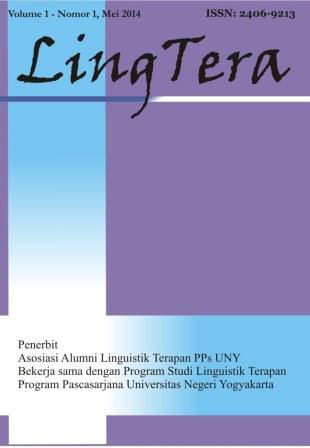The manifestation of privilege: A critical discourse analysis of the Indonesian circular letter on health protocols for international travel
DOI:
https://doi.org/10.21831/lt.v10i1.56805Keywords:
critical discourse analysis, transitivity, previlege, health protocols, circular letterAbstract
References
Anggraini, N. (2018). Transitivity process and ideological construction of Donald Trump's speeches. Sunan Ampel State Islamic University.
Burstein, P., & Linton, A. (2002). The impact of political parties, interest groups, and social movement organizations on public policy: Some recent evidence and theoretical concerns. Social Forces, 81(2), 380-408.
Dremel, A. (2014). Discourse and/as social practice: The analysis of the problem of resistance and hegemony. Mediterranean Journal of Social Sciences, 5(22), 155-166.
Fairclough, N. (1989). Language and power. Longman.
Fairclough, N. (1992). Discourse and social change. Polity Press.
Fairclough, N. (1995). Critical discourse analysis: The critical study of language. Longman.
Fairclough, N. L., & Wodak, R. (2011). Critical discourse analysis. In T. A. Van Dijk, Discourse Studies: A multidisciplinary introduction (pp. 258-284). SAGE.
Flick, U. (2014). An introduction to qualitative research (5th Ed.). SAGE.
Halliday, M., & Matthiessen, C. (2004). An introduction to functional grammar. Arnold.
Hartono, N. M. (2016). Klasifikasi jabatan dalam kelembagaan negara: Permasalahan kategori pejabat negara. NEGARA HUKUM, 7(2), 145-166.
Isti'anah, A. (2014). Transitivity analysis in four selected opinions about Jakarta governor election. Journal Phenomena, 14(22), 163-175.
Kemenparekraf. (2022, August 9). Statistik kunjungan wisatawan mancanegara 2021. Kemenparekraf.go.id. https://kemenparekraf.go.id/statistik-wisatawanmancanegara/statistik
-kunjungan-wisatawan-mancanegara-2021
Liu, Y., & Jia, W. (2019). Critical analysis and identity construction of Chinese news media. International Education Studies, 13(1), 84-88.
Lyngse, F. P. (2021, December 27). SARS-CoV-2 Omicron VOC Transmission in Danish. medRxiv. https://www.medrxiv.org/content/10.1101/2021.12.27.21268278v1
Määttä, S. K. (2017). The foundations of Europe: A critical discourse analysis of the EU constitution. Critical Approaches to Discourse Analysis Across Disciplines, 1(1), 166-178.
Martin, J., Matthiessen, C. M., & Painter, C. (2010). Deploying functional grammar. The Commercial Press.
Mills, C. W. (2000). The power elite. Oxford University Press.
Morley, G. D. (2000). Syntax in functional grammar: An introduction to lexicogrammar in systemic linguistics. Continuum.
Nordquist, R. (2020, February 5). Context in Language. ThoughtCo. https://www.thoughtco.com/what-is-context-language-1689920
Padilla, L. V., & Vana, R. (2019). Ideologies in the foreign language curriculum: insights from textbooks and instructor interviews. Language Awareness, 28(1), 15-30.
Ramdani, R., & Purnomo, E. P. (2018, April). The Success of Interest Group Coalition in Influencing the Decision Making Process in a Local Government: Case Studies of Constitutional Folk Coalition (KORSI) in Subang Regency, Indonesia. Clean ang Green Politics Conference, 2018, Chiangmai, Thailand.
Rogers, R. (2004). An introduction to critical discourse analysis in education. Lawrence Erlbaum Associates.
Salayo, J. (2020). Social distancing, community quarantine and bullets: A critical discourse analysis of pres. Rodrigo Duterte's speeches on the war against COVID-19 pandemic. Middle Eastern Journal of Research in Education and Social Sciences (MEJRESS), 1(2), 233-256.
Schoonenboom, J., & Johnson, R. B. (2017). How to construct a mixed methods research design. Kí¶ln Z Soziol, 69(2), 107-131.
Siregar, K. (2020, October 12). Singapore, Indonesia agrees to launch green lane for essential business and official travel. CNA. https://www.channelnewsasia.com/singapore/singapore-indonesia-reciprocal-green-lane-business-travel-759661
Tahir, A. (2020). Kebijakan publik dan good governancy. UNG Press.
Toolan, M. (1997). What is critical discourse analysis and why are people saying such terrible things about it? Language and Literature: International Journal of Stylistics, 6(2), 83-103.
Van Dijk, T. A. (1993). Principles of critical discourse analysis. Discourse & Society, 4(2), 249-283.
Van Dijk, T. A. (2001). Critical discourse analysis. In D. Schiffrin, D. Tannen, & H. E. Hamilton, The handbook of discourse analysis (pp. 352-371). Blackwell Publishers.
Van Dijk, T. A. (2006). Ideology and discourse analysis. Journal of Political Ideologies, 11(2), 115-140.
Wiebe, J., Hirst, G., & Horton, D. (1996). Language use in context. Communications of The ACM, 39(1), 102-111.
Wodak, R., & Meyer, M. (2001). Methods of critical discourse analysis. SAGE Publications.
Zhu, P., & Tan, X. (2021). Is compulsory home quarantine less effective than centralized quarantine in controlling the COVID-19 outbreak? Evidence from Hong Kong. Sustainable Cities and Society, 74, 1-11.
Downloads
Published
How to Cite
Issue
Section
Citation Check
License
LingTera allows readers to read, download, copy, distribute, print, search, or link to its articles' full texts and allows readers to use them for any other lawful purpose. The journal allows the author(s) to hold the copyright without restrictions. Finally, the journal allows the author(s) to retain publishing rights without restrictions.
- Authors are allowed to archive their submitted articles in an open-access repository.
- Authors are allowed to archive the final published article in an open-access repository with an acknowledgment of its initial publication in this journal.

Psychology, Evaluation, and Technology in Educational Research is licensed under a Creative Commons Attribution-ShareAlike 4.0 International License.
Based on a work at https://petier.org/index.php/PETIER.









